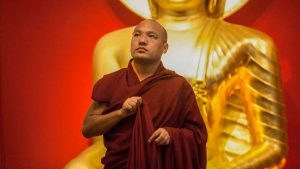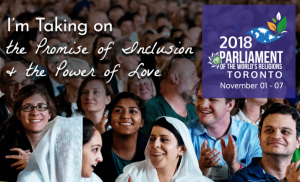
I used to feel so bored when hanging my laundry out to dry. The clothes were wet, wrinkled, and heavy, and I just wanted to do the chore quickly and be done with it.
I had a friend who I’d met in India. She was from Greece and she became one of my main art teachers. When I became pregnant and returned to my mom’s home in Brazil, she came to stay with me for a few months. With my big belly, doing housework like washing dishes, sweeping the floor, and hanging out the laundry became even more unpleasant. But it so happened that one sunny day, my friend came with me to the clothesline, and I saw her hold up this big white bed sheet and hang it perfectly, all the while smiling like Zorba himself, and exclaiming in her heavy Greek accent: “Oh, this is so poetic, this is beautiful!”
I stopped with my arms in the air. “What? What is beautiful?” I asked, and she replied: “This is beautiful—the contrast of the fabric against the sky. I feel like I’m in a movie. Everything about it is so poetic!”
It was a moment of epiphany for me. I definitely never hung the laundry in the same way again and I tried to bring this same, joyful perspective to other activities. I asked myself: what are the other things I do which I tell myself are a boring waste of time? And how many things have we been taught, from our cultural frame of reference, that ”this is “bad” and that is “good,” and which we never think to question?
There are moments in our lives when we become so entangled in bad situations that we are pulled down by their gravity into a spiral of neurotic thoughts leading to neurotic activity. There are times when we feel we have no escape, no options, no choice—it all feels horrible. But the world “out there” can’t be controlled, this we all know. After all, samsara is made of sand; empires are built with immense effort and are destroyed with a single blow. Should we insist on creating one beautiful scenario after another that waves from the sea of impermanence will soon wash away? Or can we stop for a moment? Stop and listen . . .

What are the inner mantras that I’m telling myself? What is the music to which I am dancing? Am I listening to music that is constantly saying how bad people can be and how unjust is the world in which we live? It is the moment that I believe all this is true, that I feel I have been betrayed and that all is suffering. The words I speak and repeat sculpt my inner image of myself; each thought, each repetition shaping and polishing this image. The energy I radiate out into the world attracts the particles of matter which construct my reality, dancing around me on the winds of the song that I sing, reaffirming the “unjust” world in which I live.
Little children are still-malleable sculptures of clay, so soft that any strong impact will shape their character for the rest of their lives. If a little girl loves singing loudly, but hears from her mother that her voice gives her a headache, that little girl will think that her voice is harming someone she loves and she will never sing again. And if a teacher reinforces that her voice is too loud, she will become quiet because her main compass is whether or not she is loved. Those times that she tried to let her silenced voice burst forth, she was punished, and the times she talked like everyone else, she was rewarded. Feeling loved feels good and so she learns to conform rather than learn about herself. Later she will become her own punisher and rewarder.
How many times we have believed what others have said, when they merely told us more about themselves and their own projections rather than something truly about us. How many stories have we believed were really about us? We believe we are not good, or that this feels unpleasant, or that what he has done was unfair and hurts us, and so on. And we hold on to these beliefs like Gollum’s precious ring, clutching them and protecting the belief, and creating a kind of a spell that puts us in a trance. We repeat: “she is not good” or “I am not loved.” We practice many kinds of mantras that we reinforce through daily repetition, shaping the existence of our suffering. Somehow, we care about our beliefs so much that we wouldn’t know who we are without them. Out of fear, we hold fear, thinking it is better than the unknown.

What happens if we change the mantra? “I am loved,” for example? But pronouncing it in a way that really touches our inner sculpture, shapes and polishes it, letting it infiltrate the material of all our beliefs so that it dissolves like running water over soft clay. It is quite sophisticated how so many spiritual traditions have understood and work with prayer and mantras as a means for shaping our inner sculptures into beliefs that support our better selves in the world. But the strongest mantras are still those that we create for ourselves.
Usually when we go to our friends to share our problems, we are hoping that they can offer us a different perspective on the situation. And if the friend has a broad vision or insight, it can be wonderful—we will come out of the conversation feeling so much better! So why can’t we be this friend to ourselves? I’m not suggesting creating a fantasy that everything can be a wonderful story; we must take care not to go to the other extreme. Telling stories is an art indeed, but we can also opt to not tell a story and simply see things as they are. Maybe where you can learn to take things less personally—not everything is about you, unless you believe it is.
Siddhartha’s final challenge under the Bodhi tree was his encounter with Maya, or Mara the god of Illusions. The Buddha was presented with all the stories he had been told and in which he could take part: honor the story’s veracity and become part of the cycle of existence of never-ending stories. First Mara came saying his father was sick and that he should hurry back to the palace. Next Mara appeared as beautiful, seductive women, and then as a thousand strong and fearsome warriors wanting to kill him. The Buddha took no part in the roles directed by guilt, or the impulses of desire or fear. Instead, he first took time to abandon the stories, to understand their fabrication based on told stories, given meanings, contexts, and fantasies, and then just rested there. He touched the ground in the bhumisparsha mudra calling the Earth, the stage of all stories, and asking it to be witness to his liberation. He was free.
I don’t see the Buddha’s lack of involvement as indifference but as a moment of disidentification with all roles, which made it possible for him to return to the world free. Free and able to play any role, to come in and out of it, because there were no solid sculptures or solid roles . . . it was all incredibly malleable—a play, or lila as it is called in Sanskrit.

When we believe the role we play is solid and we become attached to the suffering it generates, that is the moment we become imprisoned in it and repeat the itinerary given to us. Sometimes, to validate the love from our parents, we honor the story as a way to give the love back to them. But we can give love back without being part of the entanglements of the story.
I don’t think this is an easy path, but so much of it has to do with our awareness of the ways we build our inner landscapes, how we shape the inner sculpture that we use to represent ourselves in the world. Is this shaped only by our suffering from ignorance, fear, desire, and aversion? Or can we become real artists, shaping our own selves with more art, more sense to perceive beauty in the midst of chaos? How much can we include chaos and learn to dance in the storm and stop running from it? How can we truly accept what is, seeing things as they are, raw and naked, and not wishing to conceal it under layer after layer fabric to prevent us from seeing the simple reality that lies beneath?
It takes courage to unveil, because these veils can turn things “more beautiful,” according to the culture one comes from—like Disney did to men and women with its empty promises of eternal love and passion. This is not real, everything changes, transforms, and dies, to be reborn as something else. But at least once in our lives we follow this plot and use this romantic layer when we meet someone. It feels good, almost intoxicating. Sometimes we are aware that it’s merely a beautiful mirage but we don’t want to let go. We sustain with all our effort the romantic illusion passed on to us.
And sometimes it can be a horrible veil, provoking much pain, like the invention of borders between countries and believing that this separation is real. We are so entangled that not believing in it might cost us our life! We see our stories unfold inside other, bigger stories. We see no other way and so we follow the plot.
I truly believe that we can plant our own seeds of freedom. Even in a scenario of war, one can shape another story when our motivation is liberation. Like the incredible journey of Garchen Rinpoche, the Tibetan lama who was imprisoned by the Chinese and tortured for 20 years before being released and making his way to India. There he met His Holiness the Dalai Lama, who asked him what his biggest fear had been during those long years. Rinpoche replied that it wasn’t the fear of death or of pain, but the fear of losing his compassion toward his torturers, who became his biggest teachers. I never saw so much love radiating from a human eye. Amid war and torture, Rinpoche chose love. Difficult? Very much so. But it is also difficult and infernal to play the role of a victim. It takes all of our life energy and steals any chance we have to perceive beauty.
So today let us take a moment to hear the mantras that shape our stories, and let us be directed and guided by consciousness and awareness, which is always available—always, like the space of the sky above our heads.
See more
Related features from Buddhistdoor Global
The Proportions of Life
Remembering a Dance That Came in a Dream
Art, Culture, and Healing the World: A Conversation with Haema Sivanesan















